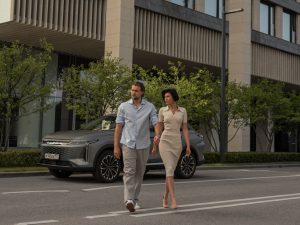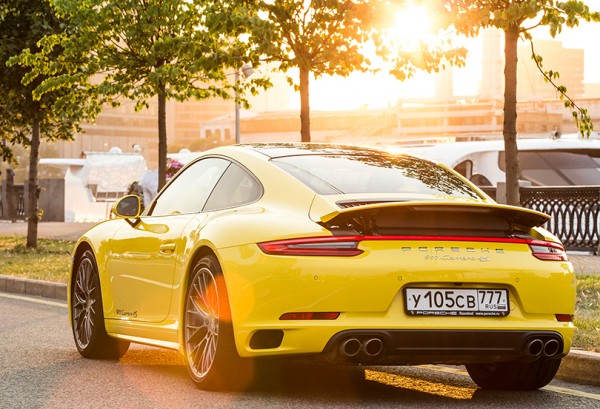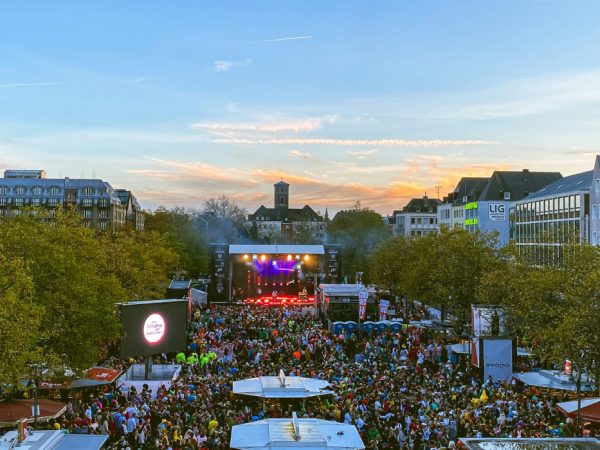Photo: Jan Coomans, Gleb Gorshkov
The Porsche 911 Carrera.
Is there any car in the world I’ve spent more keystrokes on? Probably not. Still, I promise I have a good reason to do so this time. There’s a new one, you see, but as similar as it may look to its immediate predecessor, under its skin we have a genuine revolution going on.
Porsche enthusiast go notoriously apocalyptic whenever any big changes are made to the recipe that is now more than 50 years old. When the 911 stopped using air cooled engines with the introduction of the 996 generation, some people burned their Porsche Club membership cards in protest. But as time moves forward, big change is sometimes inevitable and with the latest 991.2 generation Porsche has fitted smaller, turbocharged engines to the 911 Carrera for the first time in history. This might not sound like a big deal to you, but trust me, for many self proclaimed purists the sky has fallen. Again.
![]()
Until now, the Porsche Carrera has always had a naturally aspirated flat-6 engine which is famous for its unique sound, smoothness and throttle response. When you add turbochargers to an engine, you inevitably lose some responsiveness and it will sound a bit more like it’s trying to talk with a sock in its mouth. Sound waves which would ordinarily travel directly to your ears via the engine’s intake and exhaust now have to pass through a turbocharger first. Which is basically 2 small metal fans spinning at speeds of more than 100,000 revolutions per second at full throttle. So for some people, Porsche has simply ruined — «ruined, I tell you!» — the 911 Carrera. But have they really? I spent a week driving the new Carrera 4S to find out. And then, just to make sure, I drove some of the new 911s on Moscow Raceway as well.
I spent a good amount of time driving the «old» Carrera GTS last year, which had the tried-and-true 3.8 liter naturally aspirated engine and produced 430 horsepower. So I feel relatively qualified to weigh in on the difference in character that the new 3 liter turbo engine is bringing to the table. To get right to the point: the new Carrera is quite a lot quicker. It may be 10 horsepower down on paper, but the new engine simply feels a lot more powerful and it develops s a lot more torque at lower RPMs. For that reason, the new turbo engine will make more power on average over the useful RPM range even as it falls just short of the highest peak number of the old engine. The results speak for themselves: the new Carrera S is the first ever Carrera to do the 0-100 km/h sprint in less than 4 seconds. The 4S equipped with the PDK transmission and Sport+ will do it in 3.8 seconds. Even the slowest possible Carrera you can buy, the 370 horsepower non-S, will reach 100 km/h in 4.2, making the base car faster than the previous Carrera S which, on paper, had 30 horsepower extra. Top speeds are so high that it makes no difference — more than 300 km/h for the Carrera S and slightly less for the basic Carrera.
![]()
But of course it was never in doubt that the new models were going to be faster. Once you add turbochargers to an engine, going faster is easy. It’s just a matter of deciding how fast you want to go and choosing the boost level and turbo size to match. So is the extra power a worthwhile trade-off for the loss in sound and throttle response? It’s a difficult question to answer because it’s inherently subjective. Because I am someone who cares way too much about engine sounds, I do miss the wail from the old engines. And one does wonder for a short instant after punching the throttle pedal what’s taking so long before the rather massive power kicks in somewhere between 3500 and 4000 RPM. But progress is usually a matter of some sacrifice for a bigger gain, and I do feel that an appreciable gain has been achieved by Porsche here. And it still sounds very much like a 911 engine should, particularly at idle, it’s unmistakable for anything else than a Porsche flat-6. And the throttle response itself is really quite good, it’s just that the new turbocharged Carreras simply behave like turbocharged cars. Porsche hasn’t attempted to hide the new engine’s character, they’ve simply made the most of it, done some sound tuning where they could, and the result are undeniably impressive.
The more I drove the car, the more it seemed to me that the new Carrera S is a «light» version of the 911 Turbo now. It’s less insane, much less brutal, but otherwise very similar in the way the power is delivered and they sound a bit similar too. You can very clearly hear the turbo whistle and the typical turbo «rushing of air» on the new Carrera, but it’s never intrusive — you really need to drive with the windows down to hear it. From a value for money perspective, the new Carreras are interesting to compare to the 911 Turbo which comes with an eyewater-inducing price tag. Of course the «proper» Turbo model is a lot more insane in terms of performance, but you get a lot more freedom to configure the Carrera on Porsche’s website. Unlike the 911 Turbo, Carreras can be ordered with a manual gearbox if you wish. Or rear wheel drive. The possibilities are almost endless — which is why the Porsche configurator is probably the number 1 cause of lost productivity in my office. You can spend hours on it, and you realize eventually that you really need to buy five 911s rather than just one. It’s not particularly helpful from that perspective.
![]()
It’s amazing just how much there is to talk about the new 911, considering most people won’t even be able to tell the difference between the old car and the new. The 991.2 only looks like a tiny facelift of the old 991 — which we’ll now have to call 991.1. The front bumper is a little more aggressive, the rear lights have been updated to the new style and at the back the rear bumper now has cooling ducts to keep the turbos happy. The grille on top of the engine bay is also subtly different, again for cooling purposes rather than visual design. Porsche has also been quite adamant to point out that the 991.2 has completely new door handles that they’ve spent a lot of time and money on. I’m happy to report that they still work well to open the doors. Other than that there are some new wheels available, but you get the idea by now, the changes are pretty small. On the inside of the car I only found two changes worth talking about: the communications screen and the steering wheel. The Porsche «PCM» gets a larger display with increased resolution and multi-touch support which definitely helps when using the navigation. PCM now runs Apple CarPlay, a significant upgrade over the old system. Not that I spent any time whatsoever playing, I mean, testing, any of its functions outside of changing the radio channel. Which works fine, if you really want to know.
![]()
The steering wheel, though, is simply a massive improvement over the old one. The multifunction steering wheel, which most people tend to get, is now simply terrific. The old multifunction wheel had some of the weirdest gear shift buttons ever invented where you had to push them in to change up or pull to change down a gear. They were almost impossible to get used to, and the steering wheel itself was also a bit on the thin side. The new choice of steering wheels uses the vastly improved design first released on the 918, which feels great to use, and even with multifunction controls you still get real shift paddles on the back that you can actually use. Finally, Porsche, thank you.
![]()
So how’s the new car to drive? I guess it’s about time I start talking about that. On Moscow’s delightful roads, the Carrera 4S can best be described as a weapon. It is devastatingly efficient in the way it accelerates without apparent effort, and at no point did I feel I would have been better off with the rear-wheel drive Carrera S. Because there is just so much torque now in the middle of the RPM band, you feel that you can use all the extra traction that the all-wheel-drive system gives you. And the thing with all-wheel-drive 911s is that you barely notice that the front wheels are also being driven. It just feels very much the same as the rear-wheel-drive model in everything it does. Of course you can detect a very slight difference when you drive them back-to-back, but it’s still an engineering triumph of the highest order. For the previous generation 991.1 I would definitely have opted for the 2-wheel-drive Carrera S, but with 991.2 the 4S just seems to be the better choice for regular road use in Russia.
![]()
The new engines are also extremely well matched to the PDK gearbox. Before, on the naturally aspirated engine, I would have been tempted to get the good old fashioned manual gearbox. With the new turbo motors, PDK is even more superior than before as the turbos can keep producing boost during shifts. With a manual gearbox, the turbos would have to start all over again each time you shift. And, pointless though it might be, the PDK’s launch control function is too awesome to ignore.
All the extra power at low revs also means that the 991.2 can accelerate pretty darn rapid without even exceeding 3000 RPM. This is particularly nice if you just need to merge into traffic in a civilized manner without creating a huge amount of noise and spectacle for pedestrians. This would have been difficult with the old cars, which needed quite a lot of RPMs to get good acceleration. In the new Carrera, merely twitching your big toe on the accelerator suffices to get the car up to speed quickly and without drama. Maybe I’m just getting old, but I enjoyed being able to take off «pretty fast» without looking like an asocial idiot who «races» his loud Porsche through the city. Speaking of loudness, have you all seen how the optional sports exhaust looks on the 991.2? No? Well here it is.
![]()
Whether or not you like how the sports exhaust looks now, the main change here is that there is now a clear visual difference with the standard exhaust. The regular exhaust looks the same as it did on the old 991.1 with 4 tips, 2 on each side. But the sports exhaust now moves towards the middle and has 2 big pipes instead. I can live with the look of both personally, but if pressed for a preference I rather prefer the look of the standard exhaust. If you’re of the same opinion, I have good news for you, because I honestly could not tell the difference inside the car between the standard or sports exhaust in term of sound. As far as I could tell they sound pretty much the same. I suspect that the sports exhaust is a bit louder on the outside, with some more popping noises thrown in for good measure, but it’s nowhere near the huge difference that used to exist on the 991.1. You may remember that I was begging people to take the sports exhaust option before, well, not anymore. I’m sure you didn’t see that coming.
A new option for 991.2 which is definitely worth getting with the money you saved on the exhaust: rear wheel steering. Rear wheel steering has existed for some time already on the 911 Turbo and the 911 GT3, but this is the first time that it’s available on the Carrera. It may sound like a weird function, but Porsche has engineered it so perfectly that you would never really know the rear wheels were turning if nobody told you. It does make the car feel lighter on its feet, turn in better and it even shortens the turning radius of the car. You definitely need to tick the box for this option.
The car I tested also came with a lift for the front axle, which can raise the nose of the car a little if you have to drive over a particularly high kerb or through a particularly deep ditch, but I never felt I had to use it as the suspension isn’t really that low. Still, if you’re in a situation where ground clearance could be an issue, it’s good to finally have this option come to the Carrera as well. Overall I can sum up the 991.2 road driving experience as «pretty much perfect». The 911 has always been the sports car you’re supposed to be able to use every day, and for everyday use I think this is the best one they’ve ever made.
Which brings me to driving the new Carrera on a racetrack. Located at the Moscow Raceway track, Porsche’s Driving Center provides the opportunity to try various Porsche models with guidance of skilled instructors. I’d recommend their driving programs to anyone, the more you know about the limits of the car you drive, and yourself, the better. But away from the educational, it’s bloody good fun as well. And in this case, it gave me the useful chance to test the latest 911 without the constraints of traffic laws which slow things down. Any Porsche 911 you can buy now is simply too fast to be able to explore its full potential on the street, so a racetrack is the perfect location to get to know it better.
![]()
The Porsche Driving Center has plenty of 991.2 cars available, and all of them have the optional sports suspension and rear wheel steering for maximum performance. I swapped between the Carrera S and Carrera 4S several times, and I stand by my initial evaluation that you almost can’t tell the difference between them. The 4S felt just as sharp and eager to turn into corners as the regular 2-wheel-drive Carrera S, the only real difference was that the 4S had a lot more traction. On a bone dry race track, it simply powered out of corners without. The Carrera S on the other hand, would initiate oversteer pretty easily on corner exit in second gear when you kept your foot down. But even the rear-wheel-drive Carrera is extraordinarily well behaved on the limit.
When swapping from a 911 to a Cayman, which was also available for testing, the first thing I noticed in the Cayman was the lack of lateral grip and much more snappy oversteer compared to its bigger sister. Considering how well the mid-engined Porsche Cayman handles, it’s incredibly impressive that the 911 is not only a lot faster in the corners but also feels easier to drive while you’re at it. It’s working with you rather than against you. If you do need a bit of help or extra reassurance, the stability control system in the latest 911 finally has a setting with reduced sensitivity rather than being either fully on or fully off. In this reduced setting, the computer will let the car slide a lot more before deciding that you don’t know what you’re doing and correct the car’s slip angle. Given the sheer speed of the car and the fact that it’s mostly driven by mere mortals like myself, it’s probably the most sensible setting to use. I have absolutely no doubt that a properly equipped 991.2 Carrera S or 4S can go faster around a racetrack than a 911 GT3 from the previous (997) generation, it’s just that fast. I’m not sure if there is another car in the world that pulls of the Clark Kent/Superman transformation between normal roads and racetrack driving as well as the 911 does.
![]()
Has the 991.2 Carrera lost some things that we liked about the 991.1? The answer to that is undeniably yes — but at the same time the new car has gained qualities that its predecessor sometimes lacked. And at some point we have to face the reality that the days of the internal combustion engine appear to be numbered. We’re now looking at a huge phase-out of conventional engines between the year 2020 and 2030. The era of electric motors and batteries is knocking loudly on our door. There will be a point in the future, not too far away, when even the Porsche 911 will not be powered solely by fossil fuels. In this context, a slightly less shouty but much more powerful turbocharged engine for the 911 Carrera is a good thing. It gives us more time to enjoy the twilight days of conventional engines, a last hurrah for an era that we’ve enjoyed so much. And, most importantly, the new 991.2 Carrera still has its own and very distinct character. It’s different, but in an exciting way.
Yes, I liked it. A lot.
![]()











